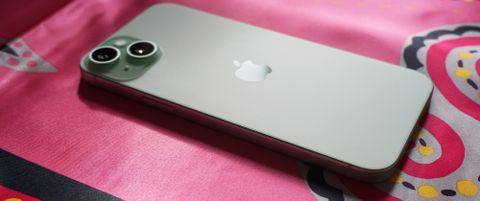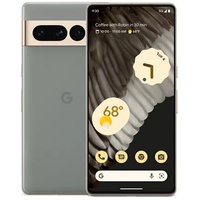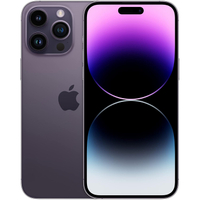TechRadar Verdict
The previous Plus was a bit like an unloved stepchild, in that it didn't sell in the same number as, for instance, last year's Pro Max. This year's model gets all the same benefits as the standard iPhone 15 – USB-C, the Dynamic Island, the A16 Bionic chip and a 48MP main camera – alongside exceptional battery life. If you can get past the 60Hz display, this is a top-tier big-screen phone worth considering.
Pros
- +
Exceptional performance
- +
Superb battery life
- +
Clean software with long update roadmap
Cons
- -
No Action button
- -
Still only 60Hz display
- -
Same data / charging speeds
Why you can trust TechRadar
Editor's Note
• Original review date: October 2023
• Launch price: $899 / £899 / AU$1,649
• Target price now: $899 / £799 / AU$1,449
Update: March 2024. The iPhone 15 Plus remains the best iPhone for battery life, and that's a title it won't lose until the presumed arrival of the iPhone 16 Plus in September 2024. Since the initial publication of this review, a similarly sized Android alternative, the Samsung Galaxy S24 Plus, has arrived on the scene, but that phone has a higher launch price than the iPhone 15 Plus. What's more, at the time of writing, the iPhone 15 Plus is on sale at Amazon in the UK and Australia, so it's now a better value proposition than ever. As for iOS 17, it's been updated with new features and sideloading options in EU regions. The rest of this review remains as previously published.

iPhone 15 Plus: Two-minute review
Ever since Apple committed to releasing a quartet of iPhones – starting with the addition of 2020's iPhone 12 mini – that fourth entry has always felt like it's struggled to find favor with audiences in the same way as its siblings. The Minis and Pluses of the last three years have consistently been the weakest performers of each batch of iPhones in terms of sales. And yet – similarly to last year's iPhone 14 Plus – the new iPhone 15 Plus offers an expertly rounded experience blended with impressive battery longevity in a cocktail you're unlikely to find anywhere else.
Launching alongside the iPhone 15, iPhone 15 Pro, and iPhone 15 Pro Max, the iPhone 15 Plus gets a few updates that make it seem more like part of the club than its predecessor did; changes that also make it more attractive to would-be big-screen smartphone buyers.
(We've also reviewed Apple's other newest iPhones, so check out our full iPhone 15 review, iPhone 15 Pro review, and iPhone 15 Pro Max review, if you want an in-depth look at what each of those entries brings to the table.)

Despite retaining the flat sides of the last few generations of iPhone, all of the iPhone 15 series – including the 15 Plus – now have softened, more rounded edges. This may be especially important for the 6.7-inch iPhone 15 Plus, since the last few generations have been tricky to wield one-handed and this small design revision has a huge impact on hand-feel, comfort and ease-of-use.
With the iPhone 15 Plus, you still get a 6.7-inch 60Hz (yep, still 60) OLED display, but now with the Dynamic Island that was exclusive to last year's iPhone 14 Pro and 14 Pro Max, instead of a notch. The phone runs on a more powerful Apple-made A16 Bionic chipset (again like 2022's Pro iPhones), while the iPhone 15 Pro and iPhone 15 Pro Max have been bumped up to the even-more-potent A17 Pro. Also, wave farewell to Lightning; like Galaxys, Pixels, and pretty much every other phone out there, the iPhone now charges via USB-C.
As for the all-important camera setup, you'll still find two lenses in a diagonal layout, but the main sensor jumps from 12MP to 48MP, delivering better still image quality in a myriad of conditions – including low light, when zooming in and when taking portrait shots, while video stabilization has been improved as a result too. The image sensor on the iPhone 15 Plus (and iPhone 15) is not exactly the same as the one found in the Pro editions but it does get most of the cool new photo tricks found on its more expensive stablemates. This includes the ability to make almost any photo a Portrait shot (even after capture), and it sports a bump in base output image resolution to 24MP (up from 12MP).
With Apple nixing a 64GB storage option a couple of generations ago, you can pick the iPhone 15 Plus up in 128GB, 256GB, or 512GB configurations. There are five iPhone 15 colors to choose from, all sporting new color-infused glass backs. In my time with the green Plus (and black iPhone 15), I think this make it one of the best-looking iPhone finishes in recent memory.
Running iOS 17 out of the box, the iPhone 15 Plus gains all the benefits we've been waiting to test out for months (ever since Apple first showed off the experience, back at WWDC 2023 in June). From Contact Posters to Interactive Widgets and even StandBy (previously thought to be a feature exclusive to iPhones with always-on displays, which the Plus still lacks); there are a number of quality-of-life improvements that long-time iPhone users will appreciate on the iPhone 15 Plus.
Thankfully, for all that is new, Apple has left pricing well alone this year in the US, while the UK enjoys a notable price drop, and the phone becomes fractionally pricier in Australia compared to last year's model. The iPhone 15 Plus is available as of Friday, September 22.
iPhone 15 Plus review: Price and availability
- Priced from $899 / £899 / AU$1,649
- On sale from September 22
- US pricing the same, UK cheaper, Aus pricier – YoY
Although there was a rumor of a range-wide price rise this year, the iPhone 15 Plus (along with the iPhone 15 and iPhone 15 Pro) stays the course in the US, meaning the standard 128GB model starts at $899, just as the iPhone 14 Plus did, one year earlier.
While the 128GB model technically undercuts Samsung on price, the pricing of the 256GB build ($999 / £999 / AU$1,849) places it directly up against the base Galaxy S23 Plus, whose name similarly emphases the phone's larger-screened design in relation to the standard Samsung Galaxy S23. The Pixel 7 Pro is also similarly priced, and continues to find itself discounted below the Plus; especially now that its (slightly pricier) successor – the Pixel 8 Pro – has freshly arrived on the scene.
| 128GB | $899 | £899 | AU$1,649 |
| 256GB | $999 | £999 | AU$1,849 |
| 512GB | $1,199 | £1,199 | AU$2,199 |
Apple introduced all four new members of the iPhone 15 family to the world at its 'Wonderlust' event on September 12, with the phone going on pre-order on Friday, September 15 and on sale a week later, on September 22.
Of course, if you're already sold on the promise of the iPhone 15 Plus, then head on over to our iPhone 15 deals roundup, where we're constantly updating the best offers available on Apple's newest entrant in the mobile market. Otherwise, read on if you need more convincing.
- Value score: 3.5 / 5
iPhone 15 Plus review: Specs
The main upgrades fall to a new camera system, the Dynamic Island and USB-C, but here's a full breakdown of all the hardware on offer.
| Header Cell - Column 1 | |
|---|---|
| Dimensions: | 160.9 x 77.8 x 7.8mm |
| Weight: | 201 grams |
| Screen: | 6.7-inch 60Hz (2796 x 1290) Super Retina XDR OLED |
| Chipset: | Apple A16 Bionic |
| RAM: | 6GB |
| Storage: | 128GB / 256GB / 512GB |
| OS: | iOS 17 (at launch) |
| Primary camera: | 48MP f/1.6 w/ sensor-shift OIS |
| Ultra-wide camera: | 12MP f/2.4 w/ 120º FoV |
| Front camera: | 12MP f/1.9 |
| Battery: | 4,383mAh |
| Charging: | 20W wired, 15W wireless (MagSafe), 7.5W wireless (Qi) |
| Colors: | Black, blue, green, yellow, pink |
iPhone 15 Plus review: Design
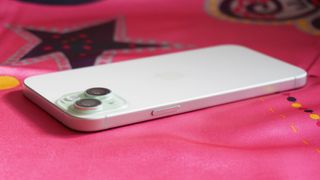
- Similar dimensions to predecessor
- Color-infused glass back
- USB-C replaces Lightning (finally)
At a glance, the iPhone 15 Plus looks very much like the iPhone 14 Plus. But closer examination reveals a newly crafted aluminum frame that gently scrubs away the sharp edges, making it much more comfortable to hold than the 14 Plus. It's also slightly lighter (by three grams, at 201g).
So long as you like pastels, this year's lineup of iPhone 15 Plus (and iPhone 15) colors includes five finishes (black, blue, green, yellow, and a truly mesmerizing pink), all of which showcase new color-infused glass, with the camera bump seamlessly rising out of the back panel. It's a good look, and probably one of the most refined iPhone finishes ever.
That aluminum frame also now plays host to a USB-C port, where there was once a Lightning port; meaning you should be able to charge with just one cable, if you already own a modern MacBook and/or iPad – with the latter finally ditching Lightning on its base iPad 10.9 (2022) model, last year.
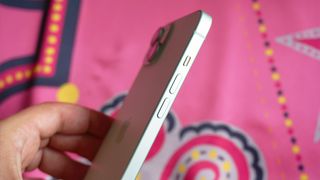
If you opt for this non-Pro iPhone 15 model, you will notice that it doesn't have that nifty new Action button. No, the 15 Plus and iPhone 15 still have the classic ring/silent switch. I'm not against this aging component, but it's definitely not Action button-level useful (you can fall back on Accessibility hacks like Back Tap to emulate similar behaviour, though).
Aside from a tweak to materials and colors, the back of the phone still plays host to a diagonal dual camera system. On the front, you'll now find an iPhone 14 Pro-like Dynamic Island, where the notch once lived, protected by Apple's Ceramic Shield (ceramic-infused glass that offers decent resistance against shatters and drops).
Apple continues to offer some of the best IP-rated protection in the business, quoting figures that actually marginally surpass its IP68 certification against dust ingress and promised water resistance.

The phone is also full of recycled materials, from the 75% aluminum frame to precious metals, like 100% recycled cobalt in the battery. Apple has plans to make its phones carbon-neutral too, but the iPhone 15 Plus is only a step on this particular journey.
A glance along the bottom edge and long-time iPhone users will also notice the port looks a little bit different to what they might be used to; a larger pill-shape with a central strip of contacts. That's no Lightning port, that's USB-C... on an iPhone, finally.
It's already been well-documented that Apple has made this switch ahead of enforcement by the European Union, but that doesn't stop it being any less novel. The first time I was able to plug my car's aux cord in via the 3.5mm to USB-C adapter that, until now, had been exclusively reserved for any Android phones I was testing at the time, was a small thrill. Being able to charge your MacBook, iPad and iPhone with single cord is liberating, especially for frequent travellers.
- Design score: 4.5 / 5
iPhone 15 Plus review: Display

- 6.7-inch Super Retina XDR OLED
- Still only 60Hz refresh rate
- Dynamic Island replaces notch
I find the larger 6.7-inch screen on the iPhone 15 Plus quite pleasing and expansive (even if the bezels are not as thin as they are on the slimmed-down 15 Pro and Pro Max). But it's frustrating that despite having an excellent Super Retina XDR OLED screen, the iPhone 15 Plus (and iPhone 15) are still stuck with a 60Hz refresh rate, while the Pro models get smooth 120Hz ProMotion panels.
It's now become an almost farcical aspect of Apple's recent non-Pro iPhones. With every generation I ask myself, "surely, this'll be the year they move past 60Hz" and the company continues to subvert my hopes and expectations. For comparison, Samsung's similarly-priced non-Ultra flagships made the jump to 120Hz starting with 2020's Galaxy S20 and S20 Plus, while Google's standard Pixels have offered 90Hz displays since 2019; with this year's Pixel 8 joining its Pro sibling, with a 120Hz display. 60Hz at a phone of this price is so behind the industry standard and yet Apple seems unwavering in its decision to hold non-Pro iPhones at this threshold.
Perhaps it's that existing iPhone users upgrading from previous non-Pro iPhones don't know what they're missing; unless you see and experience high refresh rates first-hand, you don't question 60Hz. In the same vein, another Pro-only feature that's found on most rivals is Always-On Display functionality, of which Apple's implementation is, in my opinion, the best (read my iPhone 15 Pro review for a deeper explainer as to why). Its absence on the Plus is, at least, lessened by the phone's finely-tuned tap-to-wake and raise-to-wake behaviours.
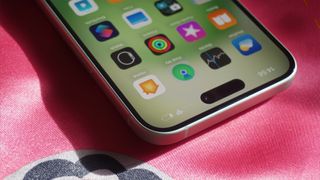
While I stand by the notion that this high-priced handset is deserving of display adaptations like a higher refresh rate and always-on functionality, it's hard to argue with the underlying hardware that is there. I haven't quibbled about resolution on iPhone for years (even if rivals are sharper), with a similar 460ppi pixel density, as before. What's more, the company has now pushed brightness to among the best on the market, with a significantly higher ceiling this year – a 1,200-nit peak has risen to 2,000 nits.
The standard iPhone 15 models also gains the 14 Pro line's Dynamic Island, and let me tell you, you will not miss the notch. While it technically encroaches further into the display than the final iteration of the notch, it's a more versatile and functional addition, even if I think there's more Apple could have done with it between generations. Everything that the Dynamic Island could already do (keep track of directions, music, your Uber) can now be achieved on the iPhone 15 Plus, and iOS 17 will hopefully continue to add new functionality over time.
- Display score: 4 / 5
iPhone 15 Plus review: Software
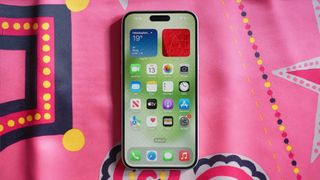
- Runs iOS 17 out the box
- New features include Check In, NameDrop and more
- At least five years of OS updates
iOS 17 feels like a comparatively minor upgrade, over the beefier features the company introduced in iOS 16. However, there are a few (which our dedicated iOS 17 review covers) of note that help enhance the user experience on the iPhone 15 Plus.
Contact Posters and NameDrop, real-time location sharing (called Check In) in Messages, automated blurring of nudity in Messages and AirDrop, Live Voicemail (complete with transcription) Interactive Widgets, and a heap more. The iPhone 15 Plus will feel completely familiar to most iPhone and iOS 16 users. Most of the major changes are embedded in various elements that don't necessarily touch the home screen by default. Still, the introduction of the Dynamic Island does make everything seem fresher.
Apple's software roadmap is, as always, one of the iPhone's greatest strengths; with an expected five years of OS updates, that could stretch to six (or beyond, depending on how things shake out in the long run). It's only beaten by Google's improved seven years of software updates promised with the Pixel 8 and Pixel 8 Pro. This could really apply pressure to Apple, after so long unopposed in this area.
- Software score: 4.5 / 5
iPhone 15 Plus review: Cameras
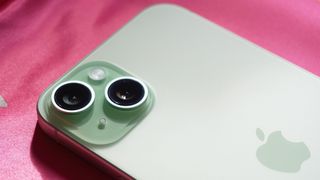
- 48MP main, 12MP ultra-wide, 12MP front-facing camera
- New 24MP standard image resolution
- Can turn standard shots into portrait photos after the fact
Design-wise, the camera system may look the same as the iPhone 14 and 13 series before it, but the iPhone 15 Plus' camera setup has a big secret. The main sensor that has – for the longest time – clocked in at 12MP, is taking a leaf out of the iPhone 14 Pro's playbook and making the leap to a 48MP sensor, complete with sensor-shift OIS (optical image stabilization).
This introduces pixel binning to the standard iPhone's photographic recipe for the first time and, alongside better shooting in all environments – including low light – and better quality 2x zoomed and portrait photography. Not to mention better stabilization, across stills and video.
More importantly, the iPhone 15 Plus (and iPhone 15) now captures 24MP images by default. This is achieved by combining the best 12MP of information with the full detail of that new 48MP sensor (this tends to make image file sizes from the main camera significantly larger than previous-generation 12MP stills, so shutterbugs might want to consider higher storage options). You also get an effective 2x optical zoom, which is not a zoom lens but takes the middle sub-section out of that full 48MP sensor – as the 14 Pro's camera did.
Beyond the main sensor's megapixel bump, the iPhone 15 Plus' ultra-wide still stands at 12MP, as does the front-facing camera (even if it is now concealed within the Dynamic Island), and across the board, you're shooting with capable sensors here.
iPhone 15 Plus camera samples

Primary camera

Ultra-wide camera

2x zoom

Portrait mode on the primary camera

Primary camera

2x zoom portrait mode

Portrait mode on the primary camera

Primary camera

Macro shooting

Macro shooting

Primary camera

Ultra-wide camera

Portrait mode on the front camera

Front camera

Primary camera

Primary camera in low light

Primary camera in low light

Ultra-wide camera in low light

Primary camera

Primary camera comparison

Primary camera comparison in low light

Primary camera comparison





That new main 48MP snapper isn't the same as the sensor leading the charge on the back of the iPhone 15 Pro line. But in side by side tests I saw an impressive level of consistency between the two; with regards to color accuracy, dynamic range, contrast and detail – even in low light. Apple's unquestionably pushed the standard color science of the entire iPhone 15 line this year; leading to more vibrant and higher contrast shots than long-time users might be used to. I prefer this additional 'pop' – which is closer in style to the more heavily-processed shots rival Samsung phones produce – but you still have a wealth of editing tools and Photographic Styles to keep the final result in check, if you prefer a more muted finish.
One of the coolest new photographic software tricks is the iPhone 15 Plus' ability to shoot in normal photo mode and turn compatible images into portrait mode shots after the fact; meaning you don't have to shoot in portrait mode from the get-go to get that creamy bokeh and give your snaps a more professional finish. Thanks to the TrueDepth camera on the front, even your selfies come with depth data. As such, you capture pictures with people, dogs or cats in, and so long as the 'f' (for f-stop) icon appears in the corner, depth data gets collected. You can then adjust the depth effect and even change where the focus sits in frame; it's a really powerful addition and works very well.
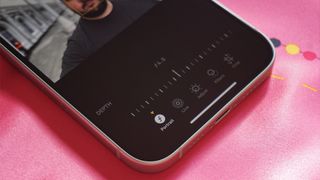
Those on the Android side of the fence may recognize some of this functionality – namely the ability to adjust and refocus after capture on Samsung phones (plus a few others). However, such shots still need to be taken in portrait mode to begin with. The iPhone 15 Plus' implementation is much less restrictive.
Video is, as ever, excellent too. If you plan on shooting a lot – for social or otherwise – iPhones offer some of the most dependable high-quality footage in the smartphone space. The 15 Plus lets you capture standard video at up to 4K at 60 frames per second, use Cinematic Mode at up to 4K 30fps (think portrait mode for video, with the same focus-pulling trick while recording during capture) and Action Mode is on-hand to offer wonderfully stable footage, helped by that larger sensor and sensor-shift optical image stabilization.
Of course, if you're aware of the 15 Pros, you know that for the extra money you get a third rear camera (a 3x zoom telephoto on the iPhone 15 Pro and – for the first time on an iPhone – 5x optical zoom on the iPhone 15 Pro Max). For those truly serious about video capture this generation's Pro models sport 4K 60fps ProRes and Log capture, with support for external recording to a hard drive. This makes them great for longer shooting sessions, professional editing pipelines and post-capture color grading; things that non-Pro iPhone users likely don't care too much about, unless you do. In that case you might want to consider skipping this Plus and saving for a Pro Max instead.
- Camera score: 4 / 5
iPhone 15 Plus review: Performance
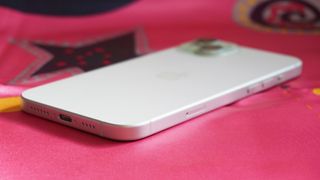
- 4nm Apple A16 Bionic chipset
- 6GB RAM & up to 512GB of storage
- Known thermal issues at launch that Apple has addressed
With the iPhone 14 series, Apple created a larger divide than fans were used to, by sticking the base iPhone 14 and 14 Plus with the same A15 Bionic chip that had been range-wide a year prior, while the iPhone 14 Pro and Pro Max received exclusive access to the more powerful and power efficient A16 Bionic. For 2023, that two-tier processor trend continues, with the iPhone 15 Plus (and iPhone 15) gaining access to last year's 14 Pro-only A16 Bionic chip, while this year's 15 Pro models sport the even-more-capable A17 Pro.
With the iPhone 14 Pro still absolutely flying and out-performing many current-gen Android flagships in artificial benchmarks, there was little to suggest that its deployment in the iPhone 15 and 15 Plus would do anything to dull its potency. That's especially true with a modest 60Hz display to power (rather than the Pro line's adaptive 120Hz panel), and sure enough that's precisely the case.
In my time with the 15 Plus, the A16 Bionic (paired with 6GB of RAM) proved it could handle pretty much anything thrown at it. Based on benchmarking (a Geekbench 6 multi-core score of 6539, compared to the Galaxy S23 Ultra's equivalent score of 5365), there's clearly plenty of headroom that ensures this phone will age gracefully, making it ideal for those after a long-term smartphone.
As for gaming, that large, bright display paired with the graphical grunt of the A16 makes for a competent duo running even the most demanding games – such as Genshin Impact – which happily ticked along at default settings (high) at 60fps (manually upped from 30fps) with only mild warming on the Plus' back.
On the subject of heat, at the time of writing, numerous independent reports have raised concerns over a more prominent heat build-up issue that seems to span the entire iPhone 15 line (meaning the issue isn't isolated to just A16 Bionic or A17 Pro-powered phones). It doesn't appear to be directly linked to running high-performance tasks and while I didn't run into this issue during my time testing the Plus out, I did encounter it during testing for my iPhone 15 Pro review. Thankfully, this issue looks to be short-lived, with Apple promising to address the issue via software updates, without compromising on performance.
Storage remains unchanged from last year, with a baseline of 128GB, a 256GB option, and 512GB at the top of the ladder (the iPhone 15 Pro also starts at 128GB while the Pro Max starts at 256GB). The only major cause for concern – as mentioned in the camera section – is the increased resolution of pictures and the subsequent file size bump that brings. While a few more MBs on a single image might not seem like much, a change like this can add up.
- Performance score: 5 / 5
iPhone 15 Plus review: Battery

- 4,383mAh battery w/ USB-C charging
- 20W wired, 15W wireless (MagSafe), 7.5W wireless (Qi) charging
- Best battery longevity of any recent phone we've reviewed
Sound the trumpets, throw some confetti, we have a new battery champion! The iPhone 14 Plus impressed with its battery longevity last year but the iPhone 15 Plus reaches new heights. It doubles the screen-on time of phones like the Motorola Edge 40 Pro / Edge Plus 2023 (5.25 hours of screen-on time) and even Apple's own iPhone 15 Pro (5.5 hours of screen-on time), with a record (by our own testing) 10.25 hours of screen-on time. This equates to up to two days of use per charge, although I'd more confidently tell people to expect a day's use with wild abandon, no battery percentage peeping required.
While this is the first Plus to boast USB-C charging in place of Lightning, there's sadly no uptick in charging performance over its predecessor. Apple still quotes 50% charge in 30 minutes and the same 15W and 7.5W wireless charging speeds for MagSafe and the Qi-standard respectively. But in testing – using Apple's own 30W USB-C charger (sold separately) – the Plus charges at a peak 20W and reached 53% in 30 minutes, with 100% reached in 1:53.
- Battery score: 5 / 5
Should you buy the iPhone 15 Plus?
| Attributes | Notes | Rating |
|---|---|---|
| Value | A 60Hz display on 2023 flagship phone at this price isn't OK. | 3.5 / 5 |
| Design | The subtle tweak to the frame's shape, the color-infused back glass and USB-C make this one of the nicest iPhone yet, in terms of look and feel. | 4.5 / 5 |
| Display | A new brightness ceiling, excellent OLED colors and contrast, and the added functionality of the Dynamic Island, make this a great expansive display. 60Hz is well behind the curve, however. | 4 / 5 |
| Software | Familiar for long-time iPhone users with some nice quality of life improvements and great long-term update support. | 4.5 / 5 |
| Camera | If you don't need Pro features, the Plus serves up great shots across the board and gains new versatility too. | 4 / 5 |
| Performance | The 14 Pro series already had a lead on the current Android rivals and that phone's same chip now powers the Plus. Top flagship performance, with longevity and headroom. | 5 / 5 |
| Battery | The more modest display refresh rate works in the Plus' favor, helping it deliver the best battery life on the market. | 5 / 5 |
Buy it if...
You want one of the most powerful phones on the market
Sure, the iPhone 15 Plus stands in the shadow of the A17 Pro-powered 15 Pro and Pro Max, but that doesn't stop it from being an absolute powerhouse in its own right, able to take on rival flagships that cost a good bit more.
You need great battery life
The battery longevity of the iPhone 15 Plus is truly astounding and one of the phone's biggest selling points, as a result. It would be nice if it charged faster, but that's not a big deal, considering you'll have plenty of time to find a plug point before the Plus gives up the ghost.
You tend to hold onto phones for a long time
Apple's ever-impressive software support, the headroom offered by that powerful A16 Bionic at the phone's heart, great cameras and long battery life render the iPhone 15 Plus ideal for those who tend to use their phones for three or more years (60Hz display notwithstanding).
Don't buy it if...
You want super-smooth visuals
On a phone that breaks the $1,000 mark (at higher storage capacities), a 60Hz display just isn't okay. It's an arbitrary limitation imposed by Apple to push you towards its Pro models and practically every other similarly-priced rival surpassed 60Hz years ago.
You want fast charging
Even though the iPhone 15 Plus delivers stellar battery life and over 50% charge in 30 minutes isn't that bad at all, 20W peak wired charging is behind the curve and a full charge still takes almost two hours.
You need that telephoto camera
The camera performance from the iPhone 15 Plus is exceptional but versatility is hampered by the lack of a telephoto sensor. The Pixel 8 takes better digitally zoomed shots and it's cheaper too.
iPhone 15 Plus review: Also consider
While the iPhone 15 Plus is a strong all-rounder, there are holes in its repertoire. If that's the case, these alternatives serve up a similar experience while addressing those pain points.
Samsung Galaxy S23 Plus
The go-to Android-based alternative to an iPhone is a Samsung and the similarly-sized Galaxy S23 Plus sports flagship performance and ecosystem integration in a fashion not dissimilar to the 15 Plus.
Google Pixel 7 Pro
Google's 2022 flagship boasts and excellent similar-sized display, a clean take on Android, designed by Google itself and a camera experience that stands ahead of its competitive price tag; which is even lower, now that the pricier Pixel 8 Pro is here.
iPhone 14 Pro Max
A nicer display, an additional telephoto camera, faster charging and – one year on from release – all for around the same price as the Plus.
| Samsung Galaxy S23 Plus | Google Pixel 7 Pro | iPhone 14 Pro Max | |
|---|---|---|---|
| Price (at launch): | From $999.99 / £1,049 / $1,649 | From $899 / £849 / AU$1,299 | From $1,099 / £1,199 / AU$1,899 |
| Dimensions: | 76.2 x 157.73 x 7.62mm | 162.9 x 76.6 x 8.9mm | 77.6 x 160.7 x 7.85mm |
| Weight: | 195.5g | 212g | 240g |
| OS (at launch): | Android 13 | Android 13 | iOS 16 |
| Display: | 6.6-inch (2316 x 1080) adaptive 48Hz - 120Hz Dynamic AMOLED 2X | 6.7-inch 1440 x 3120 19.5:9 adaptive 10Hz to 120Hz LTPO OLED | 6.7-inch (2796 x 1290) adaptive 120Hz Super Retina XDR OLED |
| Chipset: | Snapdragon 8 Gen 2 for Galaxy | Google Tensor G2 | Apple A16 Bionic |
| RAM: | 8GB (LPDDR5X) | 12GB (LPDDR5) | 6GB |
| Storage: | 256GB / 512GB (UFS 4.0) | 128GB, 256GB, 512GB (UFS 3.1) | 128GB / 256GB / 512GB / 1TB (NVMe) |
| Rear Cameras: | 50MP main, 12MP ultra-wide, 10MP 3x telephoto | 50MP wide, 12MP ultra-wide, 48MP 5x zoom | 48MP main, 12MP ultra-wide, 12MP 3x telephoto |
| Front camera: | 12MP | 10.8MP | 12MP |
| Battery: | 4,700mAh + 45W wired, 15W wireless, 4.5W reverse wireless | 5,000mAh + 23W wired, 23W wireless (2nd-gen Pixel Stand), 12W wireless (Qi) | 4,323mAh + 27W wired, 15W wireless (MagSafe), 7.5W wireless (Qi) |
How I tested the iPhone 15 Plus

- Review test period = 3 weeks
- Testing included = Everyday usage w/ web browsing, social media, photography, video calling, gaming, streaming video, music playback
- Tools used = Geekbench 6, Geekbench ML, GFXBench, native iOS stats, Apple 30W USB-C MacBook Air charger
Following the launch of the iPhone 15 line, I was invited to Apple's Battersea HQ in London to be taken through the key new features of all four iPhone 15 models, before taking review samples away to test for this review and beyond.
After three weeks of living with the iPhone 15 Plus, I assembled this review, focusing on all the key aspects that potential buyers would likely want to know about when it comes to living with this device.
I also tested battery life and recharge times, used the camera in a myriad of common scenarios and kept notable rivals on-hand – like the Pixel 7 Pro – for direct comparison. I also conducted benchmarks with publicly available tools like Geekbench 6, Geekbench ML to test the phone's new NPU and GFXBench to better assess graphical capabilities – although the display's 60Hz refresh rate and iOS itself collectively cap the frame rate at 60fps, which the 15 Plus was able to reach in almost every test.
As for charging, as Apple doesn't include a power adapter in box, I used an official 30W USB-C charger (usually used to power my M1 MacBook Air) to reach the phone's peak charging speed of 20W.
As a reviewer with 12 years experience and having reviewed numerous iPhones in my career, I felt confident assessing and scoring the iPhone 15 Plus, relative to other iPhone models, as well as the wider smartphone market in which it competes.
First reviewed October 2023

Alex joined as TechRadar's Senior Phones Editor in June 2022, but brings over a decade's worth of experience to the role, with an expertise in smartphones, tablets and wearables. He's covered keynotes hosted by the biggest brands and attended the launches for some of the most influential mobile products of the last few years. His experience was amassed at some of the most reputable consumer technology publications out there, including GSMArena, TechAdvisor and Trusted Reviews.

Google's AI-powered bug hunting tool finds a host of concerning open source security flaws

Apple just confirmed its annual Black Friday shopping event, and it's all about gift cards

Would you pay $2000 for the most extravagant laptop of 2024? GPD's double foldable convertible laptop goes on sale — with world's fastest mobile CPU and even an OCuLink connector
